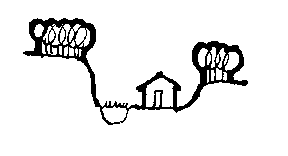SITE PLANNING
Design Considerations:
Site selection - All attempts should be made to reuse an existing
building before building a new structure. Site selection should involve a
demographic investigation of location of growth. A new building being built should
be located in area where there is the shortest commute for the majority of
occupants. The amount of commuting by cars and parking needed to relocate employees
and occupants produces an enormous amount of pollution and has a major negative impact on
the surrounding natural environment. As well, the redevelopment of an urban or
suburban site will cause less damage than bulldozing virgin property.
Campus versus high-rise (site density/ layout)- Design a campus
setting, where the buildings are no more than two stories and spread throughout the
site. High rise buildings disturb the surrounding neighborhoods, buildings, and
trees by blocking sunlight and creating wind tunnels. Campus layouts are more
sensitive to the surrounding environments, and they encourage walking.
Solar access & orientation- Locate your building on a site
where ample sunlight is available. Know where the sun rises and sets in order to
capitalize on natural lighting.
Prevailing winds- Use vegetation and topography for wind and snow
protection. Hide buildings behind hills and trees. This reduces the energy
load on buildings.
Adjacent buildings- Find out the rules and regulations of your
site. Incorporate these into the location and design of your building.
Disturbance of site throughout construction- The building must
be located on the site in such a way that the removal of trees and vegetation is
minimized. Protect the natural features and vegetation of the site during
construction process by designating access routes, parking staging, storage, and work
areas. Provide a physical buffer such as a temporary fence between these areas and
those that need to be protected. Truck access throughout construction should be
confined to areas which have the least impact on the site. Heavy equipment should be
kept to a minimum, and it should always utilize designated access routes. Watershed areas
should be carefully handled.
Construction waste management- Resource conservation should be
promoted by recycling and/or reusing existing building materials whenever possible.
Hire local contractors or share contractors with other local projects to minimize energy
consumption and decrease waste. Also designate areas for separation and recycling of
materials at the job site.
Access/ egress & circulation- Paving for vehicles should be
limited to main access corridors, parking garages, etc. Pedestrian paths from cars
to buildings should combine pavement with grass in order to reduce erosion and integrate
nature. Paving materials and content should be made of recycled and natural paving
materials, such as recycled glass and concrete, stone, wood, etc.
Outdoor lighting & safety- Provide an adequate amount of
energy efficient outdoor lighting, such as high pressure, low “E” sodium
lamps. Computer modeling will help to achieve a balance between a good amount of
lighting for safety purposes and too much lighting that creates light pollution.
Tools:
Solar access & orientation- Computer modeling (DOE-2)
Disturbance of site throughout construction- Develop construction methodology for a
commitment to an ecologically sustainable agenda
Construction waste management- Develop construction methodology for a commitment to an
ecologically sustainable agenda
Outdoor lighting & safety- Computer modeling (DOE-2)
Case Studies to research:
Information on case studies can be located with the resources listed in "further
information"
Site selection:
City of Austin, TX.;Western C-9 Basin Plan; Dade and Broward Counties, FL.; Duany Plater-
Zyberk and Dover, Kohl and Partners.
Stapleton Redevelopment Plan, Denver, CO.
Cooper, Robertson and Partners.
The Botanical Park at the National Museum of Natural Science Taichung, Taiwan (located at
a 15-acre urban site)
HOH Associates.
Adjacent buildings:
Inland Revenue Center, Nottingham, England
Michael Hopkins & Partners, Architect.
Solar access & orientation:
Harmony: A Center for the Study of Sustainable Resort Development, St.John, Virgin
Islands.
James Hadley Architect
Boyner River Ecology Center, Shelbourne, Ontario
Douglas B. Pollard Architects
Further Information:
"Sustainable Cities: can architects ecological design beyond buildings to the urban
scale?" McKee, Bradford. Architecture. Vol. 84, No.7, July 1995, pp.61-65.
"Center of the Earth" Mays, Vernon. Architecture. Vol. 83, No.6, June 1993,
pp.52-57.
"In Nature's Arms", Landecker, Heidi. Architecture. Vol. 83, No.6, June 1993,
pp.70-73.
EPA Green Building Standards
Primer on Sustainable Buildings
Web resources
U.S. Department of Energy: EPIC - Pollution
Prevention Information Clearinghouse
Idaho National Engineering Laboratory, Enviro$en$e
National Extension
Water Quality Database
Universities Water Information Network
|
